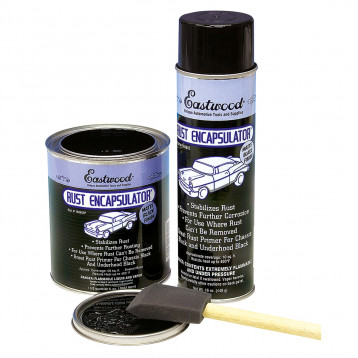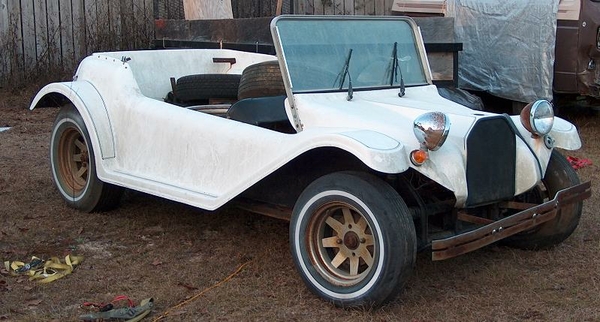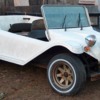Recently I read an article on Aircooled.net in which they advise to install Zerk fittings on the shock towers in order to fill them with grease and prevent rusting of the beam. With the quality/quantity of replacement front beams dwindling I have thought about doing this in my car. Has any of you done this and if so; where exactly are the Zerk fittings installed? Thank you all in advance.
Replies sorted oldest to newest
I have an old dune buggy that has rust holes on the bottom of either side of the lower shock towers. Seems dirt/sand and water get trapped in there and it rusts. I t5hink grease fitting is over kill. Why not spary under coating or frame coating. I'd spray it up thru the bottom drain hole and tape around that drain to hold it till it tries.


Attachments
There is a current discussion of this on thesamba. I replied there that I filled my shock towers with expanding urethane foam. I also filled the void on the pan where the master cylinder is attached and the IRS trailing arms.
I did it more than 30 years ago and haven't noticed any problems.
I believe Carey at Beck gets all their beams from Airkewld now. They are well-made and available. No need to worry.
Fluid Film is a lanolin based liquid that is used by some 4x4 owners. They spray the insides of the frame and inside bottoms of doors and panels. It never completely dries, seeps into seams and seals anything it touches from the atmosphere, keeping rust at bay. It's popular with Toyota FJ Cruiser owners (and I'm guessing Toyota Tacoma owners as well), where (wherever the roads are salted in the winter) frames rusting out from the inside is an issue. Some guys cover the whole underside of their trucks with it once a year. I read about it on the FJ Cruisers forum.
https://www.fluid-film.com/pro...ol-non-aerosol-bulk/
If you're worried about your front beam towers rusting out I think it would be perfect- drill a small hole up fairly high, spray the insides and then close the hole with a plastic plug. Al
PS- there's also a cosmoline based spray available as well, which dries to a hard(er) almost waxy finish
I have some Fluid Film but I can't remember what I used it for.
Mustie1 on YouTube, who’s a very respectable mechanic uses bar chain oil under his cars to protect them from the salts they use on the roads in New Hampshire. He dilutes it a little bit and sprays it liberally under the car and just like Fluid Film and cosmoline it sticks to the metal without being runny.
Rust happens when condensation forms on any inner panel of metal and suddenly rust starts. Brakes are notorious for rusting in any environment, any wonder they ship greased and wrapped in plastic to the end user.
Living in the north with salt most of my life I have tried and seen used a lot of commercial products and all sorts of rust prevention methods.
Open Gear spray on grease, for out of the way places if you can stand the grease has been used on cars and works well, I have also seen people mix all kinds of oil and grease mixtures on DD to prevent salt erosion, but you have to live with too much of a mess IMO. VW used to use a wax based WAXOYL when they would send their cars to America and that formula is pretty much a Eucerin based product, it is waxy, and it is based on Anhydrous wool fat, aka lanolin. Film Liquid is also in that league and there are commercial similar products. Some of these can also softnen rubber so be careful to keep it away from them.
These days Krown, Rust Check, pretty much have a very liquidy product that can creep into the seams but does not have much surface adhesion in highly exposed areas like flat panels under you car. Film LIquid used by commercial shops is in the same boat.
I had IM use Wurth anti rust products to spray the inside of the frame and I continue to add a bit of Krown or Film Liquid yearly to it. You can buy a can and search Amzn to get a longer tube to spray further into the frame it will is done in a hot day run a bit as you drive and keep your car frame from rusting.
There is another product called Nutz that is a wax based product, which again looks like a surface protectant that is often used for electronics etc that can be used but it is mostly for smaller areas and small equipment and not a general car rustproofing agent.
Something else that I find handy is Rust convertors like Evaporust and rust check rust conversion primers. They are basically enzymes or acid based converters of rust and help to stop the rust then you can paint over them.
I did a full rebuild of a hockey game sometime ago and just let all the old screws soack in the evaporust and the screws came out like new.
Anyway, sure glad we have GLass cars it helps to stop my OCD on rust prevention from going overboard ![]()
When I first started working, back in the early 1970’s, one of my co-workers had a VW bus as a daily driver. “VW Mike” religiously drained his motor oil every 3,000 miles on both his and his wife’s cars, dumped that oil into a bug sprayer and, using that long sprayer wand, sprayed it inside his doors, through drilled holes on the back sides of the door sills, around the inside of the wheel wells, all over the place that had voids that might rust. After spraying it in/on/through, he would park his bus “out back” and let it drip out. The drain oil smell would dissipate in a few days.
There was no rust on Mike’s bus - anywhere, and this was in northern Connecticut where the use of road salt back then was almost religious. His rational was, “you never see a rusty oil can!”
His method worked. I would probably use a less stinky oil, but the application process works.
@Gordon Nichols posted:When I first started working, back in the early 1970’s, one of my co-workers had a VW bus as a daily driver. “VW Mike” religiously drained his motor oil every 3,000 miles on both his and his wife’s cars, dumped that oil into a bug sprayer and, using that long sprayer wand, sprayed it inside his doors, through drilled holes on the back sides of the door sills, around the inside of the wheel wells, all over the place that had voids that might rust. After spraying it in/on/through, he would park his bus “out back” and let it drip out. The drain oil smell would dissipate in a few days.
There was no rust on Mike’s bus - anywhere, and this was in northern Connecticut where the use of road salt back then was almost religious. His rational was, “you never see a rusty oil can!”
His method worked. I would probably use a less stinky oil, but the application process works.
That was certainly before the days of EPA, etc. Nowadays you get crucified if caught doing this...🤣
His rational was, “you never see a rusty oil can!”
New guy just moved from Boston down to NW FL. Discovered he needed a new oil pan - the old was a thin as aluminium foil. Said you could bend it with you thumb. Of course he had just epoxy painted his garage floor and that's how he noticed the leak.



